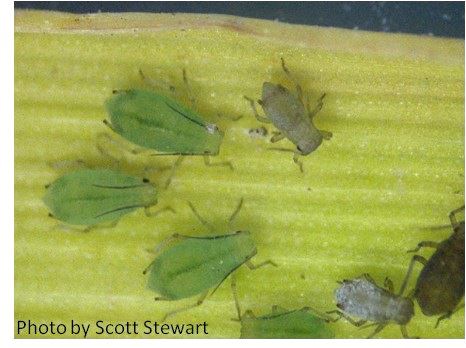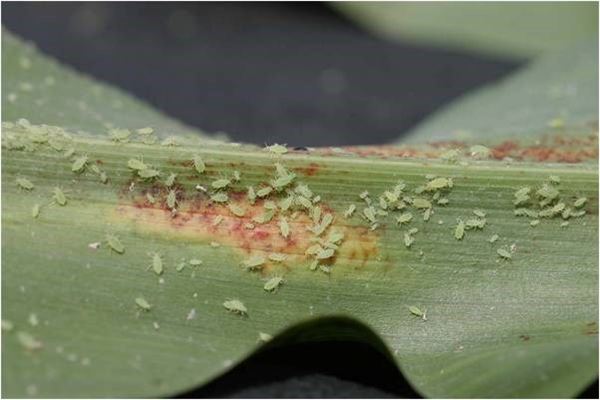Aphid Management In Wheat
SEBE BROWN AND DR. DAVID KERNS
WINNSBORO, LA.
The most common aphids found on wheat are rice root aphid, bird cherry-oat aphid, corn leaf aphid and Russian wheat aphid. Green bug are rarely an issue in Louisiana and this is the only aphid species that causes direct feeding damage to wheat causing discoloration and speckling of leaves. Aphids also vector a disease named barley yellow dwarf virus (BYDV). Wheat can be severely affected by BYDV and infection can occur from seedling through heading; however; yield loss is greatest when seedling wheat is infected in the fall. The bird cherry-oat aphid and corn leaf aphid are the most important vectors of BYDV in the fall. Aphids will move, feed and reproduce when temperatures are above 48°F increasing the likely hood of virus transmission. Dense stands in the fall caused by excessive nitrogen fertilization can cause an increase in aphid activity leading to greater infection rates of BYDV as well.

Greenbug aphids
Photo by S. Stewart UT
Aphid Management
Planting date has a significant impact on aphid infestation and BYDV infection in the fall. Earlier plantings will generally have greater aphid numbers and a greater incidence of BYDV. Furthermore, ISTs are an effective fall insect control option that will help protect seedling wheat from aphid populations and reduce insect induced stress as the season progresses into the winter months. The ISTs Gaucho 600 at 1.6 fl. oz./100 lb of seed, Cruiser 5FS at 1.33 fl. oz./100 lb of seed and Nipsit at 1.79 fl. oz./100 lb of seed are options available to producers. These treatments will help control fall infestations of aphids, however; do not expect these treatments to provide spring insect control from stink bugs, armyworms, Hessian flies, or migrating aphids.

Greenbug symptomology Photo by A. Catchot MSU
Foliar applications to control aphids are usually unnecessary when wheat varieties are planted during the recommended planting interval in Louisiana or when an IST is used. However, if wheat is planted too early, a foliar application may be justified if aphids get an unusually early start; scouting can help determine this decision. As such, the threshold for greenbug in Louisiana is as follows: plants with less than three tillers treat when 50 or more aphids are present per linear foot, plants with 3 or more tillers 3 – 6 inches tall treat when 100 – 300 or more aphids are present, plants 6 - 10 inches tall treat when 300 – 500 aphids or more are present. ∆
SEBE BROWN: Assistant Agent, LSU AgCenter
DR. DAVID KERNS: Entomologist, LSU AgCenter